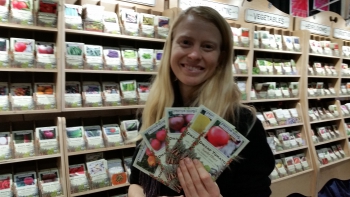
Very, very few seeds are produced commercially in the Northeast today. Until the early part of the 20th century, almost all seed was locally produced, harvested, and planted—and thus, regionally adapted to some degree. The mainstream seed industry today, however, emphasizes plants that can deliver a one-size-fits-all performance across a broad geography. As a result, hundreds, if not thousands, of varieties have left commercial production.
Should we care?
One person who’s convinced we should is Petra Page-Mann of Fruition Seed.
According to Page-Mann, local adaptations to weather, sunlight, soil, diseases, and even insects can make all the difference in growing success, particularly if you want diverse food varieties or grow ornamental plants under severe conditions.
“Local adaptation makes it possible to grow a much wider variety of food crops without transporting the finished produce thousands of miles,” says Page-Mann. “We get the health benefits of fresh, locally grown food without sacrificing variety.”
How do seeds adapt? Page-Mann suggests we think of it as a language.
“English 200 years ago isn’t the same as the English we speak and write today,” she says. “Languages are constantly evolving, and seeds are the same way.”
Indeed, you can develop your local seed varieties with a little learning and attention to detail. Check out Seed Savers Exchange, an Iowa non-profit that not only facilitates seed distribution but also teaches people how to save seed (www.seedsavers.org). Or read one of the classics on seed saving, Seed to Seed by Suzanne Ashworth.
See the complete text of this article at Zip06/TheDay: Seeds are like language, able to adapt. Or download the print version below.
| Attachment | Size |
|---|---|
| 863.22 KB |
